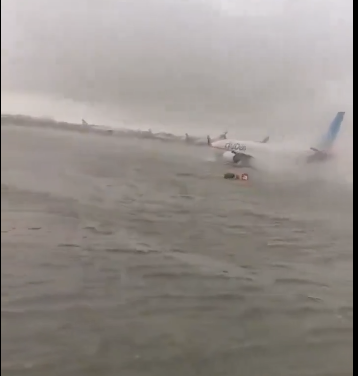Torrential rains across the United Arab Emirates prompted flight cancellations, forced schools to shut and brought traffic to a standstill.
REPORT: The current storm that is thrashing the United Arab Emirates is the largest rainfall event for the country in 75 years.
— Collin Rugg (@CollinRugg) April 16, 2024
Some outlets are reporting that the country has received over 6 inches of rain, doubling their yearly average.
10 students in the neighboring country… pic.twitter.com/fvvOydkRvM
The heavy rains that caused widespread flooding across the desert nation stemmed partly from cloud seeding. The UAE started cloud seeding operations in 2002 to address water security issues, even though the lack of drainage in many areas can trigger flooding.
JUST IN: Dubai International Airport forced to divert flights after torrential downpour causes the runway to look like an ocean.
— Collin Rugg (@CollinRugg) April 16, 2024
Citizens are being told to stay inside as thunder, lighting, hail and heavy rain slams the region.
Dubai saw more rainfall in one day than they… pic.twitter.com/hCvbprxUSK
The UAE Research Programme for Rain Enhancement Science (UAEREP) announced last month that it is looking for ways to develop the capability to analyze a cloud’s seeding potential, with even more scrutiny. The move will transform the way cloud seeding is done, with the hope of increasing rain volume from clouds.
Cloud seeding involves artificially generating rain by implanting clouds with particles. In the UAE, silver iodide is often used as the cloud-bursting catalyst (a yellow substance you might have handled in science class now and again).
n fact, the UAE cloud-seeding programme first started at the end of the 1990s and reportedly produces a minimum of 15 percent additional rainfall each year alone.
Why use cloud seeding?
Countries suffering from drought can benefit from cloud seeding and with the UAE being one of the most arid regions on earth, a little precipitation here and there is bound to reap the benefits: from national water security to crop growth support.
Today they saw the outcome of over-rigorous seeding after six applications. The runway looks like it’s in an ocean.
Dubai airport looks like an apocalyptic movie. Videos of the flooding are insane.
— Robby Starbuck (@robbystarbuck) April 16, 2024
I’ve seen some blaming climate change when the cause is actually from the use of weather modification.
Cloud seeding where chemicals are sprayed in clouds to create rain caused this. We recently… pic.twitter.com/AoejGxJNnt
